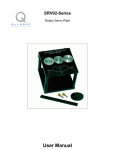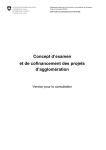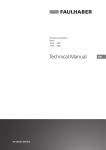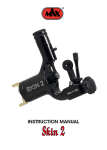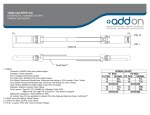Download Operating Instructions Motion Controller 2 - u
Transcript
Motion Controller 2-Quadrant PWM for Brushless DC-Servomotors Series BLD 5604 Series BLD 5608 Operating Instructions c om ww w. fau l h er. b a Miniature Drive Systems Micro Drives DC-Micromotors Precision Gearheads Servo Components Drive Electronics Surf to the following Internet address and you will find the latest edition of the instruction manual on-line: www.minimotor.ch/uk/pr/ For direct Download: http://www.minimotor.ch/minicatalog/pdf/DriveCircuits/Manuals/IM_e_BLD_5604_5608.pdf Index General information 1. Description 2. Illustration Technical data 3. Maximum ratings 4. Specific characteristics 5. Dimensions and weight General characteristics 6.1 Speed command 6.2 Speed regulator, type PI 6.3 Direction 6.4 Brake 6.5 Protection against motor stall 6.6 Excess -temperature protection 6.7 Basic circuit diagram Start-up procedure 7.1 Procedure 7.2 Connection diagram Notice of use 8.1 Power supply 8.2 Wiring General information 1. Description The BLD 5604 and the BLD 5608 are 2-quadrant PWM (Pulse-Width Modulation) servo amplifiers ideal for the speed control of our three-phase brushless DC-servomotors: • 5604 for motor types 1628, 2036 and 2444; • 5608 for motor types 3056 and 3564. The commutation sequence of the servomotor phases is made electronically by the servo amplifier. A specially designed frequency-to-voltage converter allows precise speed regulation via the Hall sensors without the need of an encoder (regulator type PI, proportional plus integral). The combination of MOSFET power stage and PWM technologies enables both compact design and high power efficiency. Both amplifiers are provided with thermal and motor stall protection and pulse-by-pulse current limitation. For the BLD 5604-SH2P the current limit is set to 4A; without additional heat sink, the maximum continuous output power is 150W. The BLD 5608-SH2P is set to 8A ; the maximum continuous output power is 250 W. 2. Illustration Connector X2 to connect power supply and command signal Connector X1 to connect the brushless DC-servomotor LED signals a protection intervention and the servo amplifier desactivation Heat sink with four mounting slots Fig. 1 2 Specifications subject to change without notice Technical data 5604-SH2P 3. 3. Maximum ratings Power supply Analog and logical inputs Voltage for the pull-up fault output (8 mA max. sink current) Continuous output current @ TA = 22°C 60 –0,3 to 5608-SH2P 60 –0,3 to 5 12 3 4. Specific characteristics Power supply PWM switching frequency Current limit (pulse-by-pulse current limiting) Total standby current, Hall-effect sensors supply included Efficiency max. Analog speed command: (1) - voltage range - frequency bandwidth - input impedance Logic inputs Output voltage for external use (100 mA max. load) Speed gain Maximum controllable speed (2) Minimum controllable speed (3) Operating temperature range Storage temperature range V DC V DC 5 12 5 V DC A 10 ÷ 56 25 4 10 ÷ 56 25 8 120 95 120 95 0 ÷ 5 10 460 TTL 5 12 000 60 000 800 0 ÷ 5 10 460 TTL 5 6 000 30 000 800 0 ... + 70 –20 ... +120 0 ... + 70 –20 ... +120 V DC kHz A mA % V DC Hz kΩ V DC V DC rpm/V rpm rpm ˚C ˚C 1) analog speed command may be set by an external potentiometer or an external voltage the maximum speed depends on the power supply, the motor type and the load 3) the minimum speed depends on the motor type, the inertia and the viscous friction of the load 2) 5. Dimensions and weight Scale reduced 114,3 4 Dimensions length 114,3 mm width 100 mm height 28,7 mm 1 1 8 X2 2 X1 3 100 Weight 200 g 4 C 5 6 7 LED 1 8 8 5 6 28,7 102,3 3 Fig. 2 Specifications subject to change without notice General characteristics 6. General characteristics 6.1 Analog speed command The speed command is given by an external voltage from 0 to 5V or by a potentiometer connected directly to the servo amplifier (see fig. 4). The total potentiometer resistance must be between 10 kΩ and 47 kΩ. Furthermore, a PWM signal with a maximum amplitude of 5V and a minimum frequency of 1 kHz can be used as a speed command. 6.2 Speed regulator, type PI A Proportional plus Integral (PI) speed regulator controls a brushless DC-servomotor with no steady-state error (step input command). 6.3 Direction The direction of rotation is changed using either a high or low input signal (TTL compatible). When a high input signal is given or the input is unconnected (internal pull-up resistance), the motor turns in the clockwise direction (CW). When a low input command is given or the input is connected to GND, the motor turns in the counterclockwise direction (CCW). 6.4 Brake This feature allows the motor to brake dynamically by applying a low input signal to the BRAKE input. The braking torque is proportional to the speed: at standstill, there is no torque applied to the motor. This logical input also has the function to reset the servo amplifier when an error message is given via the red LED. We recommend using this feature at speeds below 10 000 rpm. 6.5 Protection against motor stall This protection is a special feature to preserve the motor in case of mechanical blocking or motor stall. The servo amplifier will be disactivated after few seconds, when the motor is powered, it does not turn. At the same time this intervention will be signalled by the red LED and with the activation of the Fault Output (open-collector). To reset and reactivate the servo amplifier it is necessary to turn the BRAKE input low and then high. 6.6 Excess temperature protection The servo amplifier automatically shuts off if the heat sink temperature exceeds +75 °C. When the temperature is below +70 °C the servo amplifier can be restarted with the BRAKE input. 4 Specifications subject to change without notice Start-up procedure 6.7 Basic circuit diagram Vm GND Speed amplifier Analog speed command Fault output + Phase Phase Phase BLM Driver – * A B C Brushless DC-Servomotor 1628, 2036, 2444, 3056, 3564 + 5V Hall sensor A Hall sensor B Hall sensor C Brake Direction CW/CCW +5V GND F/V converter Logic * Excess temperature protection, current limiting and protection against motor stall. 7. Start-up procedure 7.1 Procedure • Connect the servo amplifier according to the diagram (see fig. 4) • Only switch on the power once all wires have been connected • Verify the operation; if the red LED is on then check the connections and reset via the BRAKE input. 7.2 Connection diagram X2 X1 1 GND power supply 2 Vm power supply 3 4 5 6 7 8 GND Logic Analog speed comm. + 5 V (output) Fault output Brake Direction (CW/CCW) 8 7 6 5 4 3 2 1 Brown Phase A Orange Phase B Yellow Phase C Black GND Logic Red + 5 V (output) Grey Hall sensor C Blue Hall sensor B Green Hall sensor A Brushless DC-Servomotor 1628, 2036, 5 2444, 3056, 3564 Specifications subject to change without notice Notice of use 8. Notice of use 8.1 Power supply Any unstabilized power supply voltage within the servo amplifier range (10V ≤ Vm ≤ 56 V) may be used, although it is advisable to keep this voltage as low as possible in order to minimize the electromagnetic interferences (EMI). Thus the optimum power supply is given by the following relation: Vm [V] ≈ 5 [V] + R [Ω] · Imax [A] + kE [V/rpm] · nmax [rpm] with R : kE : Imax : nmax : terminal resistance of the motor phases; back-EMF constant of the motor; maximum current reached by the motor in your specific application; maximum speed reached by the motor in your specific application. 8.2 Wiring A well known disadvantage of pulse-width modulation, is the large amount of interferences generated. This has two consequences, namely perturbations to the environment and self perturbations. The EMI are generated in the motor power leads and induced in the Hall-effect sensor wires. The smooth running of the motor is therefore perturbed and even in some cases, the motor will not run at all. In order to reduce the effect of these perturbations, there are some basic rules to follow: • use wires as short as possible; • avoid to run signal wires (logical and analog command, Hall-effect sensors signals) in close proximity to power lead wires (power supply and servomotor phases); • connect shielded wires to ground at one end only to avoid ground loops. A special care should be given to the motor connection. The following table summarizes the different solutions: 6 Specifications subject to change without notice Notice of use Action To From Self Length 1. No special care no no no 0.3 m 2. Twisted wires (see fig. 5) slightly slightly slightly 1.0 m 3. Shielded Hall-effect sensor wires (see fig. 6) 4. Shielded Hall-effect sensor and phases wires (see fig. 7) no yes yes 5.0 m yes yes yes 5.0 m with To: From: Self: Length: perturbations to environment reduced perturbations from environment reduced self perturbations reduced maximum cable length In case of wires longer than the standard product (0,3 m) it is recommended to use the following cable sections: Phase, DC-Servomotor type 1628 ... B: Phase, DC-Servomotor type 2036 ... B: Phase, DC-Servomotor type 2444 ... B: Phase, DC-Servomotor type 3056 ... B: Phase, DC-Servomotor type 3564 ... B: 0,5 mm2 1,0 mm2 1,0 mm2 1,5 mm2 1,5 mm2 Hall-effect sensors, all DC-Servomotor types: 0,5 mm2 / AWG 20 / AWG / AWG / AWG / AWG / AWG 20 18 18 16 16 Note: If wires are longer than 5 m please consult us. 7 Specifications subject to change without notice Twisted wires Figure 5 Brushless DC-Servomotor Brown Orange Yellow Black Red Grey Blue Green Phase A Phase B Phase C GND Logic + VCC Hall sensor C Hall sensor B Hall sensor A 8 7 6 5 4 3 2 1 Connector X1 Shielded Hall sensor wires Figure 6 Brushless DC-Servomotor Brown Orange Yellow Black Red Grey Blue Green Phase A Phase B Phase C GND logic +VCC Hall sensor C Hall sensor B Hall sensor A 8 7 6 5 4 3 2 1 Connector X1 Shielded phase and Hall sensor wires Figure 7 Brushless DC-Servomotor Phase A Phase B Phase C GND logic + VCC Hall sensor C Hall sensor B Hall sensor A Brown Orange Yellow Black Red Grey Blue Green 8 7 6 5 4 3 2 1 Connector X1 8 Specifications subject to change without notice The FAULHABER Group: DR. FRITZ FAULHABER GMBH & CO. KG Daimlerstraße 23 71101 Schönaich · Germany Tel.: +49 (0)7031/638-0 Fax: +49 (0)7031/638-100 Email: [email protected] www.faulhaber.de MINIMOTOR SA 6980 Croglio · Switzerland Tel.: +41 (0)91 611 31 00 Fax: +41 (0)91 611 31 10 Email: [email protected] www.minimotor.ch MicroMo Electronics, Inc. 14881 Evergreen Avenue Clearwater · FL 33762-3008 · USA Phone: +1 (727) 572-0131 Fax: +1 (727) 573-5918 Toll-Free: (800) 807-9166 Email: [email protected] www.micromo.com ©MINIMOTOR SA Edition 29.05.2000











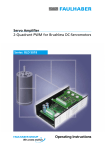
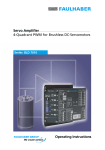
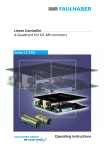
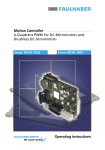
![Final Report - [Almost] Daily Photos](http://vs1.manualzilla.com/store/data/005658230_1-ad9be13b69bd4f2e15f58148160b0f22-150x150.png)
